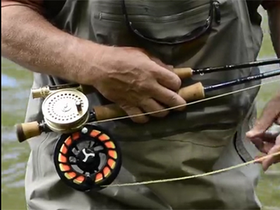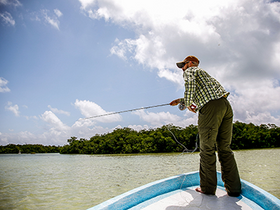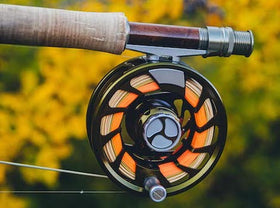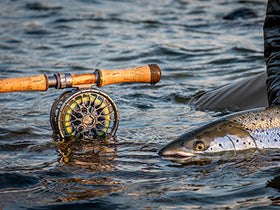Fly Fishing in Tasmania: Your 2025 Guide
Tasmania is renowned as a world-class fly fishing destination, attracting flyfishers from near and far to its crystal-clear rivers, remote highland lakes, and diverse fish species. Known for its pristine natural environments, this island state provides unique opportunities to catch wild trout in settings that range from easily accessible rivers to challenging, rugged landscapes.
Tassie rivers are typically spectacular but it's the Central Highland lakes that are the jewel in the crown. Most of the lakes are high altitude, shallow waters that can be easily waded through and offer sight fishing that's not too dissimilar to wading a saltwater flat for bonefish.
Whether you’re after trophy-sized trout or simply want to experience the natural beauty of Tasmania’s waterways, The Flyfisher is your trusted source for exploring and making the most of this ultimate fly fishing destination.
1. Best Fly Fishing Locations in Tasmania
Tasmania’s waters are diverse and abundant, offering prime fishing spots that cater to flyfishers of all experience levels. Each location has its unique qualities, from the famous trout lakes of the Central Highlands to the scenic river environments. Here are some of Tasmania’s best fly fishing spots and what makes them special:
Central Highlands
• Great Lake: Known for its vast waters and unpredictable conditions, Great Lake is a favourite for experienced flyfishers seeking a challenge. Brown and rainbow trout are plentiful here, with the best catches often found using dry flies in summer.
• Penstock Lagoon: This protected lagoon is a true gem for dry fly fishing and is renowned for its consistent mayfly hatches. Brown trout are abundant, making Penstock Lagoon popular among flyfishers during peak season in the warmer months.
• Little Pine Lagoon: Often regarded as a dry fly fishing paradise, Little Pine Lagoon is a hotspot during Tasmania’s famous mayfly hatches. flyfishers are drawn to its clear waters and active surface fishing, especially during warm days.
Tyenna River
Flowing through lush rainforest, the Tyenna River is an accessible and scenic river for fly fishing. Known for its high density of wild brown and rainbow trout, this river provides a rewarding experience with numerous pools and gentle runs perfect for practising different casting techniques.
Western Lakes
For those seeking adventure, the Western Lakes area, also called “The Land of a Thousand Lakes,” offers remote fishing in pristine, clear waters. Trophy-sized wild trout are common here, but access is for the fit. Flyfishers often hike long distances to reach the more productive waters, making it a truly unique fly fishing experience.
2. Best Seasons for Fly Fishing in Tasmania
Tasmania’s seasons influence trout behaviour and the techniques best suited for each period. Understanding the seasonal patterns here can help flyfishers maximise their chances of success:
• Spring (September - November): Spring signals the start of the trout fishing season in Tasmania. As waters warm, trout become more active, making this an excellent time for nymphing and streamer fishing. Expect higher water levels due to rainfall and snowmelt, which often brings trout to shallower areas.
• Summer (December - February): Peak fishing season arrives in summer, with ideal conditions for dry fly fishing. The warm weather leads to abundant insect hatches, particularly in highland lakes like Little Pine Lagoon and Penstock Lagoon, where trout feed actively on mayfly and gum beetles.
• Autumn (March - May): As temperatures cool, trout move to shallower waters. Autumn offers quieter fishing, with larger trout preparing for the colder months. Dry flies and nymphs remain effective in these calm conditions, providing flyfishers with rewarding fishing before the season winds down.
3. Species Found in Tasmania
Tasmania is known for its impressive trout populations, including brown, rainbow, and brook trout. Thanks to no hatchery stocking, Tasmania is often considered the protector of the worlds most wild strain of brown trout. Each species has its unique behaviours, adding depth to the fly fishing experience.
1. Brown Trout: The most common species in Tasmania, brown trout are found across lakes and rivers. Known for their elusive nature and selective feeding habits, they provide a rewarding challenge for flyfishers. Larger specimens can be found in more remote areas like the Western Lakes.
2. Rainbow Trout: Stocked in certain locations, rainbow trout are more aggressive than brown trout, making them an exciting catch. They are particularly active in rivers with higher currents, which offer them ample oxygen and feeding opportunities.
3. Brook Trout: Rare but highly prized, brook trout are found mainly in isolated highland lakes. Their vibrant colours and relative scarcity make them a unique catch, especially in colder, clearer waters.
4. Techniques for Tasmanian Fly Fishing
Fly fishing in Tasmania calls for adaptability and skill, as conditions can vary greatly between locations. Here are some expert techniques suited to the island’s unique waters:
• Polaroiding: When fishing for trout in Tasmanian lakes, polarized sunglasses (or "Polaroids") are essential for spotting fish in the clear waters. These lenses reduce surface glare, allowing you to see deeper into the water and spot trout in shallow areas, around submerged structures like rocks and weed beds, or near drop-offs where fish often hide. Polarized glasses help you observe fish behavior, such as surface feeding, and improve casting accuracy by letting you identify feeding fish and underwater features. Polarized sunglasses enhance your ability to target trout in the pristine lakes of Tasmania by providing better visibility and improving your chances of success.
• Casting Techniques: Mastering the double-haul is valuable in Tasmania, especially in open, windy areas like Great Lake and the Western Lakes. This technique improves casting distance and accuracy, helping flyfishers navigate challenging weather conditions.
• Gear Recommendations: For versatile flyfishing across Tasmania’s lakes and rivers, a 4-6 weight rod is recommended. Breathable waders and waterproof outerwear are also essential, given Tasmania’s cool climate and rapidly changing weather conditions.
Orvis Recon Fly Rod
The Orvis Recon Fly Rod is ideal for Tasmania’s diverse and challenging conditions. Its high-performance tapers and lightweight design provide precision for Tasmania’s pristine rivers and highland lakes. Perfect for casting dry flies on Little Pine Lagoon or handling windy conditions on Great Lake, the Recon delivers power, versatility, and reliability for wild trout pursuits.
View Orvis Recon Fly Rod5. Local Fly Patterns & Tips for Tasmania
In Tasmania, trout can be selective feeders, making it important to use local fly patterns and match the hatch closely. Here are some popular fly patterns and tying tips to suit local conditions:
Fly Patterns: Summer is ideal for dry flies that match Tasmania’s common mayfly and caddisfly hatches, while nymphs and streamers are effective in spring and autumn. Gum beetles are a must for the stillwaters during summer months. Matching fly choice to seasonal insect activity dramatically improves your chances of success.
Fly Tying Tips: Use materials that closely match local insects to increase your catch rate. Flies tied with possum fur seem to be favoured by Tassie trout, and if you could pick one colour - it would be claret.
6. Book a Guided Flyfishing Tour in Tasmania
Tasmania’s stunning landscapes and abundant trout make it a bucket-list destination for any angler. With remote wilderness lakes and easily accessible rivers, Tasmania offers something for everyone.
For those new to the area, booking a guided tour through The Flyfisher ensures access to local expertise and hidden fishing spots. We work with Australia's best guides to provide you a flyfishing experience you'll never forget.
With three Tasmanian destinations to choose from, you’ll then need to decide the number of flyfishers, the duration, and we'll do the rest. For more information on the specific destinations, give us a buzz on (03)96211246, or email shop@theflyfisher.com.au















